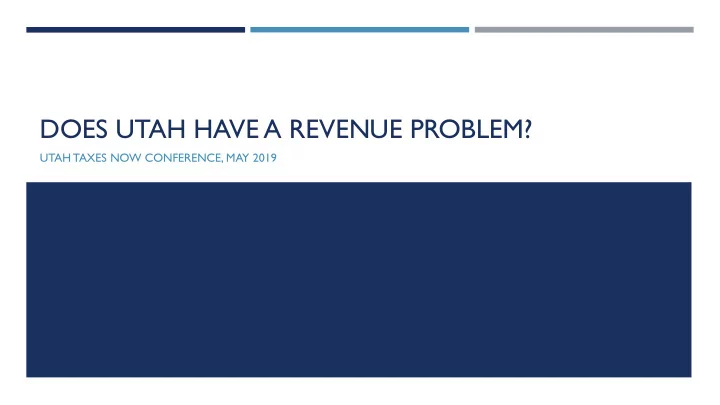

DOES UTAH HAVE A REVENUE PROBLEM? UTAH TAXES NOW CONFERENCE, MAY 2019
GENERATIONS IN UTAH, 2017 Population Generation Z 60,000 1,064,055 Millennials 34.3% 757,913 24.4% 50,000 Gen X 586,530 18.9% Boomers 40,000 511,135 16.5% 30,000 Silent and Greatest 182,170 20,000 5.9% 10,000 0 0 2 4 6 8 10 12 14 16 18 20 22 24 26 28 30 32 34 36 38 40 42 44 46 48 50 52 54 56 58 60 62 64 66 68 70 72 74 76 78 80 82 84 Age Note: Age topcoded at 85+ Source: U.S. Census Bureau, Vintage 2017 Population Estimates
LONGEST SUSTAINED EXPANSION ON RECORD (JUNE 2019) Utah job growth 8.00 Recessions 6.00 Longest on record 4.00 2.00 - (2.00) (4.00) (6.00) Source: Bureau of Labor Statistics
CHANGING EXPENDITURE PATTERNS U.S. Household Expenditures 1985 Household 2015 Household Expenditures Expenditures Not Taxabl Taxabl Not Taxabl e e Taxabl e 41% 51% e 49% 59% Source: U.S. Consumer Expenditure Survey and Kem C. Gardner Policy Institut Note: Using FY 2019 Utah sales and use tax revenue forecast
RISING HEALTH CARE COSTS Utah Medicaid Expenditures as a Percent of General Fund 25.0% 20.9% 20.0% 12.5% 15.0% 10.0% 5.0% 0.0% 2000 2001 2002 2003 2004 2005 2006 2007 2008 2009 2010 2011 2012 2013 2014 2015 2016 2017 Source: Utah Governor’s Office of Management and Budget Note: Includes earmarks
AN AGING POPULATION Utah Population 65 and Over 25.00% 20.3% 19.0% 20.00% 16.9% 16.0% 15.00% 13.5% 10.2% 10.00% 5.00% 0.00% 2015 2025 2035 2045 2055 2065 Source: Kem C. Gardner Policy Institute 2015-2065 State and County Projections
UTAH CENTENARIANS (ESTIMATED AND PROJECTED) Population 8,000 6,800 7,000 6,000 5,000 4,000 3,000 2,000 1,000 340 - 2015 estimate 2065 projected Source: Kem C. Gardner Policy Institute 2015-2065 State and County Projections
UTAH DEPENDENCY RATIOS 100 89.9 82.3 80.0 78.3 76.1 13.9 80 71.9 70.3 69.9 68.6 68.2 15.8 13.5 60 14.4 35.1 15.2 20.0 31.7 27.0 24.7 40 76.0 66.5 66.4 54.3 53.0 49.9 20 45.6 44.9 44.4 43.3 0 1970 1980 1990 2000 2010 2020 2030 2040 2050 2060 Youth Retirement Age Source: Kem C. Gardner Policy Institute analysis of U.S. Census Bureau Decennial Census data and Kem C. Gardner Policy Institute Note: Dependency Ratios are computed as the number of nonworking age persons per 100 working age (18-64 year old) persons in the population. Youth are less than 18 years old and retirement age is 65 years and older.
TOTAL STATE EXPENDITURES GROWING FASTER THAN POPULATION AND INFLATION COMBINED GF/EF Appropriations Limitation Real Per-capita Total State Expenditures $8,000 Subjected spending limited to 1985 expenditures adjusted for population growth and inflation $7,000 $6,000 Subjected spending excludes capital construction $5,000 (roads/bldgs.), debt service, and public education $4,000 Source: Utah Code Annotated Chapter 63J-3-101 $3,000 FY 1998 FY 1999 $2,000 Limit $3,738,255,000 $3,897,490,000 $1,000 Amount Subject -$3,097,841,000 -$3,270,368,000 $0 Amt Under Limit $640,414,000 $627,122,000 Source: Office of the State Auditor Source: Governor’s Office of Management and Budget, April 23, 2018.
ECONOMY, INCOME, CONSUMPTION, AND TAXABLE SALES $180 Utah GDP Billions $160 $140 Personal Income $120 Personal Consumption $100 Expenditures $80 $60 Sales Tax Base $40 $20 $0 1997 1998 1999 2000 2001 2002 2003 2004 2005 2006 2007 2008 2009 2010 2011 2012 2013 2014 2015 2016 2017 Sources: Sales Tax Base: History of the Utah Tax Structure; Utah Tax Commission; https://tax.utah.gov/esu/history/history.pdf ; p. 9-10; published Dec. 2018; accessed May 2019. All Else: Interactive Data Tables, U.S. Bureau of Economic Analysis, https://apps.bea.gov/itable/iTable.cfm?ReqID=70&step=1#reqid=70&step=1&isuri=1; accessed May 2019.
STATE INCOME AND SALES TAXES DIFFERENTIAL GROWTH RATES (IN MILLIONS) Nominal State Sales and Income Utah GDP $4,500 $200,000 Income Tax Tax Revenue $180,000 $4,000 Revenue $160,000 $3,500 $140,000 $3,000 $120,000 $2,500 Sales Tax $100,000 Revenue $2,000 $80,000 $1,500 $60,000 $1,000 $40,000 $500 $20,000 $0 $0 1970 1972 1974 1976 1978 1980 1982 1984 1986 1988 1990 1992 1994 1996 1998 2000 2002 2004 2006 2008 2010 2012 2014 2016 2018 1970 1972 1974 1976 1978 1980 1982 1984 1986 1988 1990 1992 1994 1996 1998 2000 2002 2004 2006 2008 2010 2012 2014 2016 2018 Source: History of the Utah Tax Structure; Utah Tax Commission; Source: Interactive Data Tables, U.S. Bureau of Economic Analysis, https://tax.utah.gov/esu/history/history.pdf ; p. 9-10, 166-167; published Dec. 2018; accessed May https://apps.bea.gov/itable/iTable.cfm?ReqID=70&step=1#reqid=70&step=1&isuri=1; accessed May 2019. 2019.
GAS TAX IS SLOWLY DYING AUTO-RELATED SALES TAX A TEMPORARY BRIDGE TO LONG-TERM FUNDING SOURCE Transportation Funding Sources Utah GDP $1,400 $200,000 Transp Fund $180,000 $1,200 plus Sales Tax $160,000 Earmarks $1,000 $140,000 $120,000 $800 $100,000 $600 Transp Fund $80,000 $60,000 $400 $40,000 $200 $20,000 $0 $0 1970 1972 1974 1976 1978 1980 1982 1984 1986 1988 1990 1992 1994 1996 1998 2000 2002 2004 2006 2008 2010 2012 2014 2016 2018 1970 1972 1974 1976 1978 1980 1982 1984 1986 1988 1990 1992 1994 1996 1998 2000 2002 2004 2006 2008 2010 2012 2014 2016 2018 Source: Office of the State Auditor Source: Interactive Data Tables, U.S. Bureau of Economic Analysis, https://apps.bea.gov/itable/iTable.cfm?ReqID=70&step=1#reqid=70&step=1&isuri=1; accessed May 2019.
SALES TAX BASE AS PROPORTION OF PERSONAL INCOME 80% 70% ? 60% Historical trend is downward 50% Future is uncertain 40% 30% 20% 10% Sources: 1980-2017, 2019- 2026: Governor’s Office of 0% Management and Budget and Kem C. Gardner Policy Institute. 2018: Office of the State Auditor
INCREASINGLY FUNDING HED WITH INCOME TAX TO CLOSE THE GAP 100% 90% 80% 70% 60% 50% 40% 30% 20% 10% 0% General Fund Education Fund Sources: FY 1997- 2018: Governor’s Office of Management and Budget. FY 2019-2020: Compendium of Budget Information; Office of the Legislative Fiscal Analyst; https://cobi.Utah.gov; accessed May 2019.
Recommend
More recommend